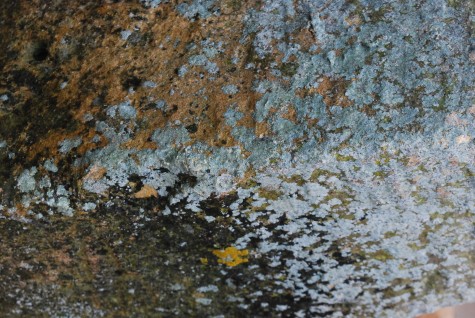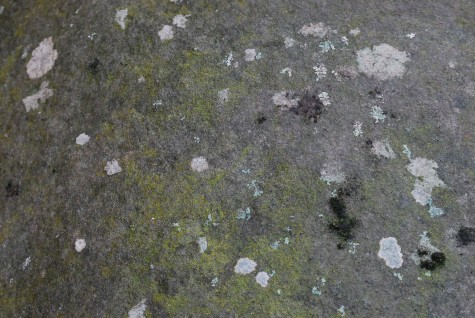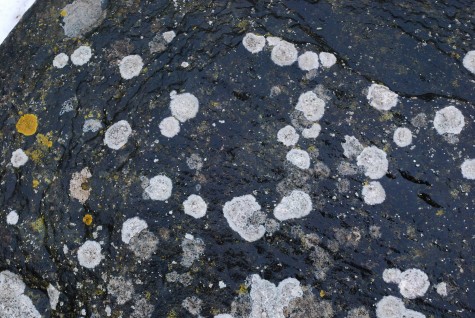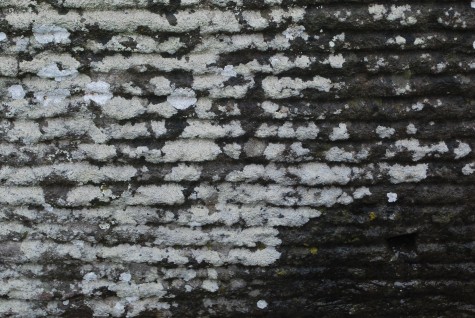At A Glance: Lichen Colonies
Stirring
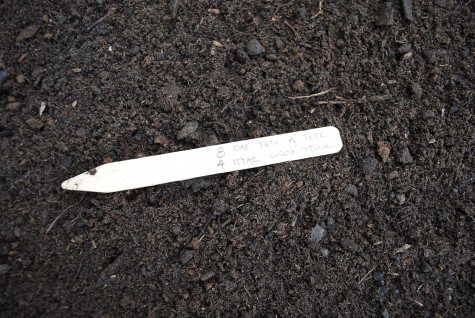
This past November, I planted a slew of spring flowering bulbs in containers. My crumbly compost based soil came from the most mature of Steve’s compost hills. Friable, this soil. I knew my bulbs would be happy. True bulbs are extraordinary, in that they house the leaves and flowers intact, and ready to grow, in an embryonic state. An entire blooming plant exists inside, ready to grow when the conditions are right. Wow. Though I have been curious, I have never had the heart to slice a tulip bulb in half to see what was inside-it always seemed like such a waste of a life. So I believe what I read about this.
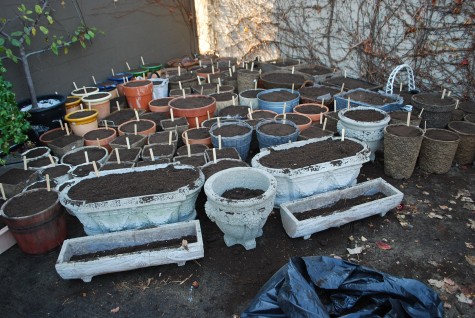
My bulbs were planted in November; they need time to root before the ground freezes hard. Planting them too late can be a problem, should winter arrive unexpectedly early. I have been told that bulbs do not freeze hard through and through when planted in the ground. Should they freeze too hard, they will rot when they thaw. I find this hard to believe, as we routinely have frost that penetrates the ground of a depth of 42 inches, but perhaps a solid freeze is different than deeply penetrating frost. This means container planted bulbs need some winter protection, as their roots are actually above ground. But should they be wintered in too warm a location, they will not get the chilling they need.
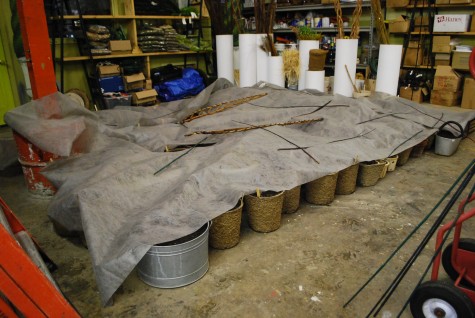 We moved the pots into the garage in late December; I did worry I had left them outside too long. The shop garage is much larger than a car garage, so space was available. We placed them as close to the adjacent heated space as possible, although we only heat that space to 45 degrees in January and February. Bulbs require a period of chilling. Cold temperatures induce a biochemical response that triggers the growth of that embryonic flower. Gardeners in frost free zones have a tough time growing bulbs unless they provide a proper chilling period. A refrigerator dedicated to chilling bulbs-I love that idea.
We moved the pots into the garage in late December; I did worry I had left them outside too long. The shop garage is much larger than a car garage, so space was available. We placed them as close to the adjacent heated space as possible, although we only heat that space to 45 degrees in January and February. Bulbs require a period of chilling. Cold temperatures induce a biochemical response that triggers the growth of that embryonic flower. Gardeners in frost free zones have a tough time growing bulbs unless they provide a proper chilling period. A refrigerator dedicated to chilling bulbs-I love that idea.
 Different bulbs have different requirements for chilling. Tulips need 14-20 weeks. Chionodoxa need 15. Once a bulb has experienced the cold it needs, it can take 2-3 weeks from breaking ground to bloom. My bulbs in containers-I am not forcing them. By this I mean I am not engineering a chilling time that would allow me to have flowers ahead of the normal spring season. I like them to bloom at exactly the same time as they would were they planted in the ground. I just like the idea of bulbs blooming in boxes, or terra cotta pots. I can move them around, or group them on my front porch. I could use a pot of tulips as a centerpiece, or a gift for a friend who is under the weather.
Different bulbs have different requirements for chilling. Tulips need 14-20 weeks. Chionodoxa need 15. Once a bulb has experienced the cold it needs, it can take 2-3 weeks from breaking ground to bloom. My bulbs in containers-I am not forcing them. By this I mean I am not engineering a chilling time that would allow me to have flowers ahead of the normal spring season. I like them to bloom at exactly the same time as they would were they planted in the ground. I just like the idea of bulbs blooming in boxes, or terra cotta pots. I can move them around, or group them on my front porch. I could use a pot of tulips as a centerpiece, or a gift for a friend who is under the weather.
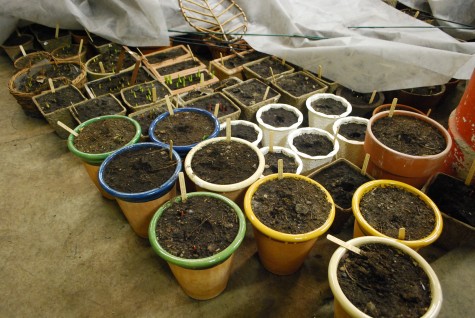 I do not heat my garage space; the extremely cold temperatures we had in February made me worry that the bulbs had frozen too hard. I checked a few pots by knocking the root ball out of some pots-they all seemed well rooted and fine. I cannot account for why this completely unheated space works. Though it is unheated, it probably is not nearly as cold as the out of doors. Perhaps geothermal heat plays a part in keeping the bulb pots just warm enough. No matter the science, I am seeing my bulbs beginning to break ground. You may wonder why I have covered my pots with landscape fabric, as well you should. Our resident cat, MCat, loves nothing better than digging into the dirt, or sharpening his claws on the trunks of old boxwood topairies we store here over the winter.
I do not heat my garage space; the extremely cold temperatures we had in February made me worry that the bulbs had frozen too hard. I checked a few pots by knocking the root ball out of some pots-they all seemed well rooted and fine. I cannot account for why this completely unheated space works. Though it is unheated, it probably is not nearly as cold as the out of doors. Perhaps geothermal heat plays a part in keeping the bulb pots just warm enough. No matter the science, I am seeing my bulbs beginning to break ground. You may wonder why I have covered my pots with landscape fabric, as well you should. Our resident cat, MCat, loves nothing better than digging into the dirt, or sharpening his claws on the trunks of old boxwood topairies we store here over the winter.
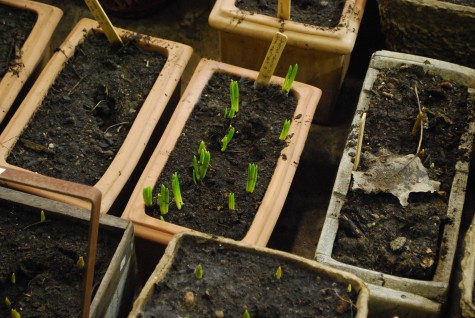 The landscape fabric and some low tech readily available weights keeps him out of these pots. Like countless other people, we accomodate the local wildlife. As you can see, the bulbs are stirring. I know that many plants go dormant in response to a season that cannot support growth. I know that low temperatures slow the chemical activity in plants as a survival strategy. But I cannot decide if these bulbs have been truly dormant. I think there has been a small fire burning here, all winter.
The landscape fabric and some low tech readily available weights keeps him out of these pots. Like countless other people, we accomodate the local wildlife. As you can see, the bulbs are stirring. I know that many plants go dormant in response to a season that cannot support growth. I know that low temperatures slow the chemical activity in plants as a survival strategy. But I cannot decide if these bulbs have been truly dormant. I think there has been a small fire burning here, all winter.
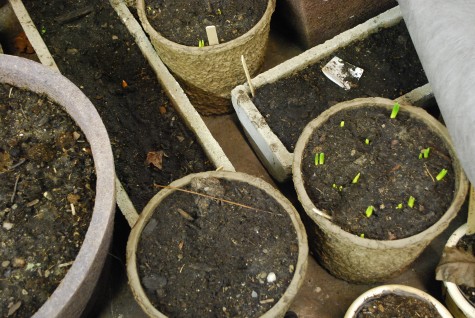
These pictures of pots of dirts with an occasional green or red shoot hardly seem exciting at first glance-you are right about that. But what is happening below the surface, and barely poking through the surface means spring is not far off-I find that incredibly exciting.
Flow Blue
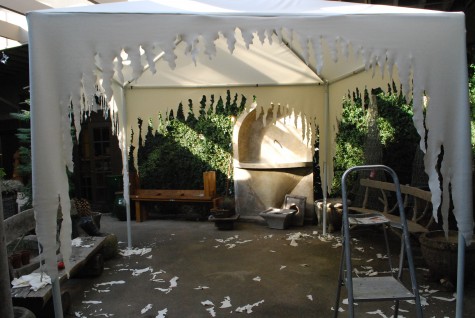 Occasionally there is an opportunity to help a client create a landscape for an event. In this case, a fundraising event for Temple Bethel involved individual participants and groups setting their own distinctive versions of a Passover Seder table. My client knew three things. She was interested in using a pavillion she ordinarily kept in her garden to create a room with a walls and a roof that would provide a framework for her table. She also wanted to set the table with her own collection of antique flow blue china. And she wanted an overall look that would be unexpectedly contemporary. I immediatey thought of billiard table felt as an appropriate material for the pavillion roof. It comes in very wide widths, and drapes beautifully. It would be striking in color, but warm and cozy in feeling-perfectly appropriate for an early March event. Cutting a series of abstract stalagtite shapes into the edges of the vertical elements of the roof would be a considerable visual departure from a traditional garden awning. We set the pavillion up in the shop-this made the cutting of the roof fabric much easier.
Occasionally there is an opportunity to help a client create a landscape for an event. In this case, a fundraising event for Temple Bethel involved individual participants and groups setting their own distinctive versions of a Passover Seder table. My client knew three things. She was interested in using a pavillion she ordinarily kept in her garden to create a room with a walls and a roof that would provide a framework for her table. She also wanted to set the table with her own collection of antique flow blue china. And she wanted an overall look that would be unexpectedly contemporary. I immediatey thought of billiard table felt as an appropriate material for the pavillion roof. It comes in very wide widths, and drapes beautifully. It would be striking in color, but warm and cozy in feeling-perfectly appropriate for an early March event. Cutting a series of abstract stalagtite shapes into the edges of the vertical elements of the roof would be a considerable visual departure from a traditional garden awning. We set the pavillion up in the shop-this made the cutting of the roof fabric much easier.
 Flow blue china originated with Staffordshire potters in England in the 1820’s. It is a white porcelain patterned transferware whose deep blue color actually comes from cobalt oxide. Many of the patterns were Asian in origin. The china is quite ornate, and delicate-but visually graphic. We repeated that white and deep cobalt blue palette simply, with the idea of creating a limited, and more contemporary look.
Flow blue china originated with Staffordshire potters in England in the 1820’s. It is a white porcelain patterned transferware whose deep blue color actually comes from cobalt oxide. Many of the patterns were Asian in origin. The china is quite ornate, and delicate-but visually graphic. We repeated that white and deep cobalt blue palette simply, with the idea of creating a limited, and more contemporary look.
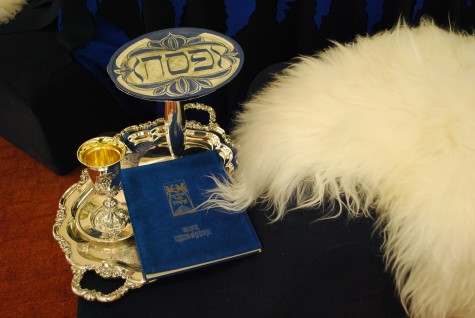 We added white unsheared sheepskin throws to each piece of a suite of mid century modern foam chairs and a chaise covered in a navy blue wool. These chairs belonged to my client, and clearly reflected her point of view. The juxtaposition of the traditional elements of the Seder celebration in a decidedly contemporary context provides visual interest. The table itself was covered in four cloths in two shades of blue, three of which had the same edge treatment as the roof.
We added white unsheared sheepskin throws to each piece of a suite of mid century modern foam chairs and a chaise covered in a navy blue wool. These chairs belonged to my client, and clearly reflected her point of view. The juxtaposition of the traditional elements of the Seder celebration in a decidedly contemporary context provides visual interest. The table itself was covered in four cloths in two shades of blue, three of which had the same edge treatment as the roof.
 The interior rails of the tent were dressed with multiple pieces of cut felt. A collection of my client’s glass drops echoed the crystal on the table, and provided a striking contrast to the light absorbing felt. Once the pavillion was set up with its cover, my client set her table.
The interior rails of the tent were dressed with multiple pieces of cut felt. A collection of my client’s glass drops echoed the crystal on the table, and provided a striking contrast to the light absorbing felt. Once the pavillion was set up with its cover, my client set her table.
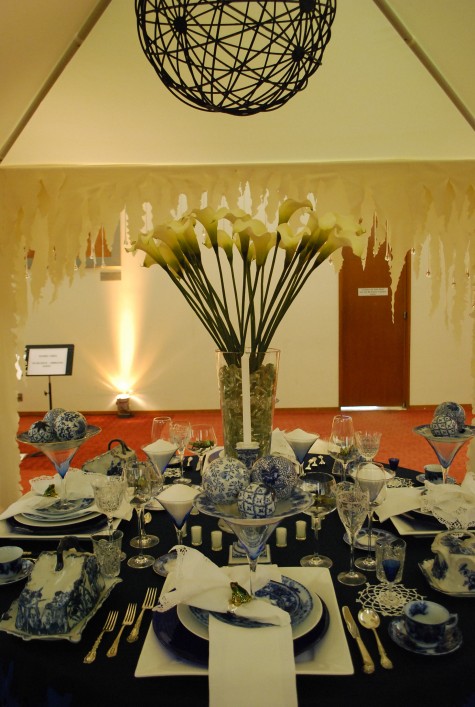 This is a very formal and very important occasion; the china, fine glassware, silver and linens reflects this. The traditional elements required in a Passover Seder dinner are represented in a graphic way. A contemporary glass vase of faux calla lilies anchored in glass ice provides some height. The ruffled edges of the callas recall the cut edges of the roof. Hung from the roof of the pavillion, a contemporary steel sphere representing the idea of a chandelier whose blue-black finish stands out against the white roof.
This is a very formal and very important occasion; the china, fine glassware, silver and linens reflects this. The traditional elements required in a Passover Seder dinner are represented in a graphic way. A contemporary glass vase of faux calla lilies anchored in glass ice provides some height. The ruffled edges of the callas recall the cut edges of the roof. Hung from the roof of the pavillion, a contemporary steel sphere representing the idea of a chandelier whose blue-black finish stands out against the white roof.
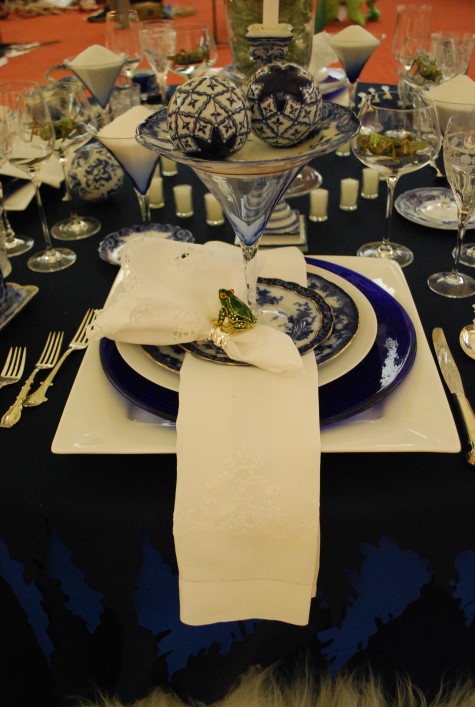 The big gestures come from the hand and eye of my client. The little and very personal touches- enamelled frog napkin rings, and a ring of elegantly narrow votive candles. The round and regular shapes of the plates, glassware and flow blue spheres is in strong contrast to the roof fabric.
The big gestures come from the hand and eye of my client. The little and very personal touches- enamelled frog napkin rings, and a ring of elegantly narrow votive candles. The round and regular shapes of the plates, glassware and flow blue spheres is in strong contrast to the roof fabric.
 People collect all sorts of things, depending on their interests. What a treat to see a collection so beautifully displayed. Better yet, a chance to work with a client whose thoughtful attention to detail, and committment to following through was considerable. The pleasure was all mine.
People collect all sorts of things, depending on their interests. What a treat to see a collection so beautifully displayed. Better yet, a chance to work with a client whose thoughtful attention to detail, and committment to following through was considerable. The pleasure was all mine.
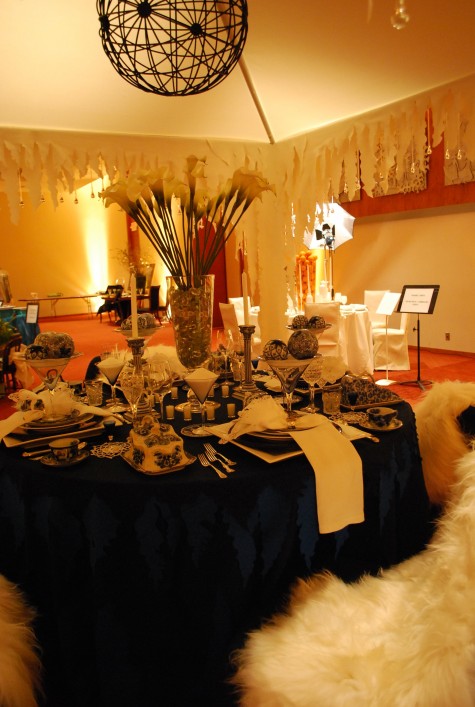
The event was to be lit softly; I am sure this added lots to the atmosphere. Every table I saw was set with the same attention of design and detail-but they were all very different. Anyone who went last night was in for a treat. But I had great admiration for this particular space. Not for what I helped with. I did help, yes-ok and fine. But she had an idea, and a committment to bringing her idea to life. This I greatly admire.
Naming Names
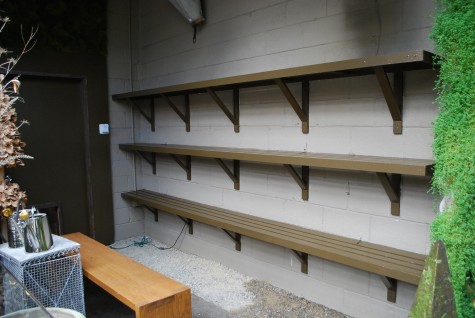 The very best part of the beginning of March? It is 12 months until it will be the end of February again. This I like. Though I have been cooped up inside like lots of other gardeners, I have an interior landscape project of my own invention to occupy some of my jail time. I truly do enjoy dismantling the entire shop, and putting it back together in some completely different form. There are many givens, and few variables in my landscape at home. The shop landscape has lots of new and some old elements. I can rearrange everything. The first order of business? Clean, and repaint. A change of color in any room can fuel a fresh start.
The very best part of the beginning of March? It is 12 months until it will be the end of February again. This I like. Though I have been cooped up inside like lots of other gardeners, I have an interior landscape project of my own invention to occupy some of my jail time. I truly do enjoy dismantling the entire shop, and putting it back together in some completely different form. There are many givens, and few variables in my landscape at home. The shop landscape has lots of new and some old elements. I can rearrange everything. The first order of business? Clean, and repaint. A change of color in any room can fuel a fresh start.
 Of course this means moving everything you own out of the way. This picture is ample evidence of what happens when an organizing idea is not in place. A random collection of objects is visually disquieting. Clash was a great band, but clash is not such a great concept for a space. How do I pick and choose, move, add and rebuild? First up, I name my spaces. In much the same way as the garden of my dreams will have a nuttery, a pond, a wildflower garden, a kitchen garden, a knot garden, the meadow walk, a corgi run, hellebore heaven, and a dining terrace-I name names. In my house, I have a reliquary (for my cherished relics) a corgi lounge (featuring a giant couch that holds the four of us) and a dressing room. The names fuel the arrangements.
Of course this means moving everything you own out of the way. This picture is ample evidence of what happens when an organizing idea is not in place. A random collection of objects is visually disquieting. Clash was a great band, but clash is not such a great concept for a space. How do I pick and choose, move, add and rebuild? First up, I name my spaces. In much the same way as the garden of my dreams will have a nuttery, a pond, a wildflower garden, a kitchen garden, a knot garden, the meadow walk, a corgi run, hellebore heaven, and a dining terrace-I name names. In my house, I have a reliquary (for my cherished relics) a corgi lounge (featuring a giant couch that holds the four of us) and a dressing room. The names fuel the arrangements.
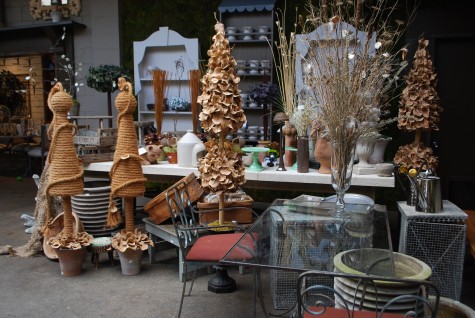 Our greenhouse space has had lots of names over the years. But this spring season, bootcamp for gardeners. Back to basics simple handmade Italian terra cotta. Good tools. Materials as in moss, pot feet, vintage trugs and galvanized steel sinks. Plainly functional objects and vintage materials have a beauty all their own-how can I arrange them to make this naming visual? Once a space gets a name, it is easier to see what belongs-and what needs to be moved somewhere else.
Our greenhouse space has had lots of names over the years. But this spring season, bootcamp for gardeners. Back to basics simple handmade Italian terra cotta. Good tools. Materials as in moss, pot feet, vintage trugs and galvanized steel sinks. Plainly functional objects and vintage materials have a beauty all their own-how can I arrange them to make this naming visual? Once a space gets a name, it is easier to see what belongs-and what needs to be moved somewhere else.
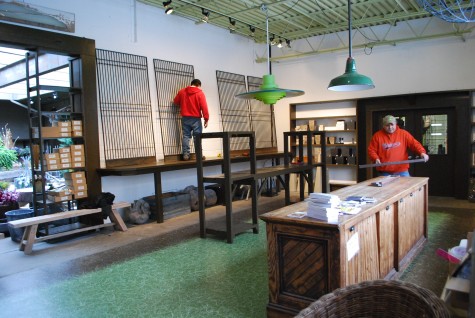 Our front room got a newly painted floor-decidedly more modern than traditional. A pair of light fixtures-one vintage industrial, and one mid century modern. The ceiling, painted steel, is much like the carport my parents had in the fifties; this part of the building was built in 1947. What name for the space comes to mind? The modern garden? Whatever words I might choose, the naming is a decision that can energize a design.
Our front room got a newly painted floor-decidedly more modern than traditional. A pair of light fixtures-one vintage industrial, and one mid century modern. The ceiling, painted steel, is much like the carport my parents had in the fifties; this part of the building was built in 1947. What name for the space comes to mind? The modern garden? Whatever words I might choose, the naming is a decision that can energize a design.
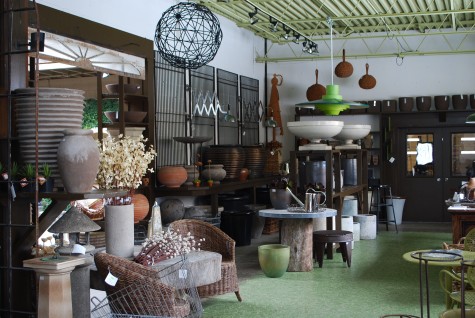 This room was easy to furnish. Every object I looked at either seemed right for the space, or seemed wrong. I paid no attention to the provenance, or history of an object. I pay attention to their visual aura. The three vintage dock bumpers hung in the airspace at the rear of this room-no one would ever characterize them as modern, or contemporary. But their simple shape and texture, their relationship to the steel sphere in the foreground makes them appropriate for this space.
This room was easy to furnish. Every object I looked at either seemed right for the space, or seemed wrong. I paid no attention to the provenance, or history of an object. I pay attention to their visual aura. The three vintage dock bumpers hung in the airspace at the rear of this room-no one would ever characterize them as modern, or contemporary. But their simple shape and texture, their relationship to the steel sphere in the foreground makes them appropriate for this space.
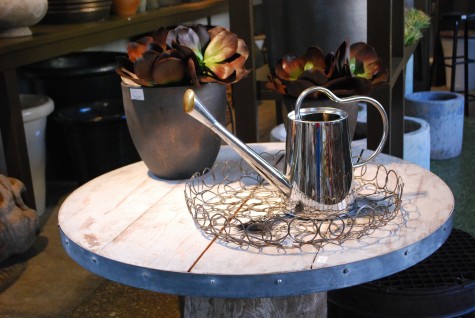 A stump based table with a plank top captured in galvanized metal-I could see this in a modern garden. A stainless steel watering can-harmonic. A tray of welded metal circles echoes and repeats the bronzy glaze and rounded form of a simple pot. This arrangement of objects makes a cohesive visual statement.
A stump based table with a plank top captured in galvanized metal-I could see this in a modern garden. A stainless steel watering can-harmonic. A tray of welded metal circles echoes and repeats the bronzy glaze and rounded form of a simple pot. This arrangement of objects makes a cohesive visual statement.
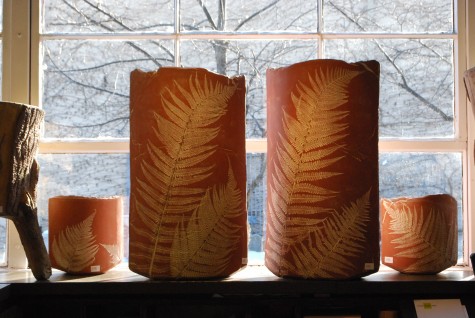 What could be more traditional, or more historic than the footprint of a fern? These contemporary English garden pots are of a shape and detail that describes a fern in a decidedly contemporary language. The shape and the top edges of these pots-edgy. How would I plant these? I need more time with them. Though they would seem out of place in my garden, I greatly admire them. They will find a name and a place, I have no doubt. A spot in the all things modern room-perfect.
What could be more traditional, or more historic than the footprint of a fern? These contemporary English garden pots are of a shape and detail that describes a fern in a decidedly contemporary language. The shape and the top edges of these pots-edgy. How would I plant these? I need more time with them. Though they would seem out of place in my garden, I greatly admire them. They will find a name and a place, I have no doubt. A spot in the all things modern room-perfect.
 I have a new pack of dogs on the way. Troy, who sculpts these for me, is an old school grower and naturalist. But his vision of the energy and beauty of a dog is so simple and spare, his sculptures warrant a place in this room.
I have a new pack of dogs on the way. Troy, who sculpts these for me, is an old school grower and naturalist. But his vision of the energy and beauty of a dog is so simple and spare, his sculptures warrant a place in this room.
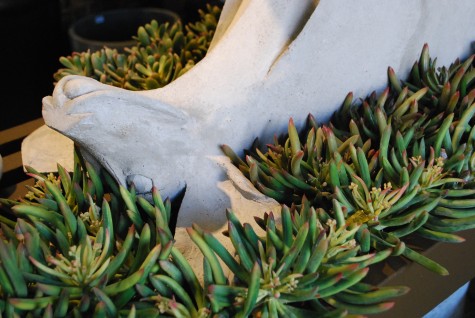
Her name is Annie. Give names to places, spaces, and gardens. You will know what to do next.
